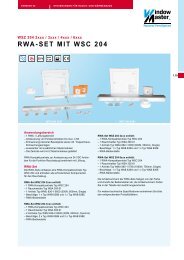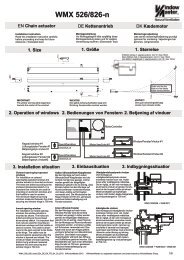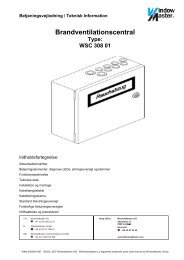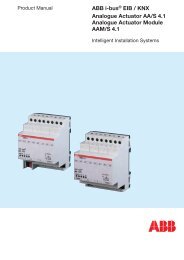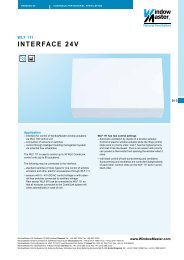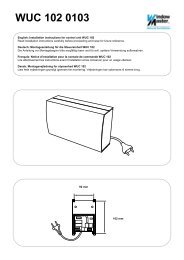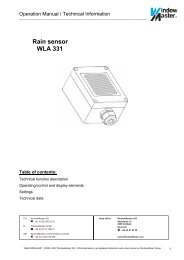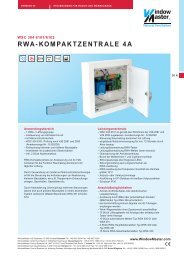ABB i-bus® EIB Universal Interfaces US/U 4.2 US/U ... - WindowMaster
ABB i-bus® EIB Universal Interfaces US/U 4.2 US/U ... - WindowMaster
ABB i-bus® EIB Universal Interfaces US/U 4.2 US/U ... - WindowMaster
You also want an ePaper? Increase the reach of your titles
YUMPU automatically turns print PDFs into web optimized ePapers that Google loves.
<strong>ABB</strong> i-bus ® <strong>EIB</strong><br />
<strong>Universal</strong> <strong>Interfaces</strong><br />
<strong>US</strong>/U 2.2, GH Q631 0074 R0111<br />
<strong>US</strong>/U <strong>4.2</strong>, GH Q631 0070 R0111<br />
“All combinations”<br />
This switching sequence runs through all the combinations of communication<br />
objects in succession. Only the value of one communication object is modified<br />
between two switching levels. A concrete example of this sequence is<br />
e.g. the switching of two groups of luminaires in the order<br />
00 – 01 – 11 – 10 – 00 ...<br />
A table of grey code can be found in the appendix under section 7.1.<br />
Further possibilities<br />
Apart from modifying the switching level via the operation of the input, it can<br />
also be changed via the communication objects “Level increment/decrement”.<br />
This is used for example to switch up or down with two or more inputs.<br />
On receipt of a value at this communication object, the behaviour is identical<br />
to an operation at the input.<br />
Note: The current switching level is continually produced from the<br />
status of the communication objects. If e.g. a communication<br />
object is modified by another device, the current switching level<br />
can also be changed as a result.<br />
5.8 Pulse counter<br />
The pulse counter function is used to count binary switching impulses.<br />
It contains all the important characteristics that are required by a highcapacity<br />
counter.<br />
The following diagram provides an overview:<br />
Input pulse<br />
Reset<br />
Counting register<br />
Differential counter<br />
Counting register<br />
Absolute value<br />
Read out after<br />
time request<br />
<strong>EIB</strong><br />
Factor/divider<br />
Preset value<br />
Apart from the absolute counter, it is possible to enable a differential counter<br />
which measures differential values (e.g. comparable with a daily mileage<br />
indicator). To be able to adapt the count rate, factors and dividers can be set<br />
for both counters.<br />
Both counter values can either be sent cyclically on the bus or on request.<br />
They have definable overflow values.<br />
The overflow of the differential counter can be sent via telegram on the bus.<br />
This telegram can be used to read out the absolute counter content.<br />
The absolute counter content is sent continually on the bus after an adjustable<br />
change.<br />
A bus voltage failure can lead to the deletion of the counter values.<br />
Note :<br />
The maximum counting frequency may not exceed 5 Hz.<br />
The minimum pulse duration is 50 ms. The maximum capacitive<br />
load at the input is 22 nF.<br />
46



